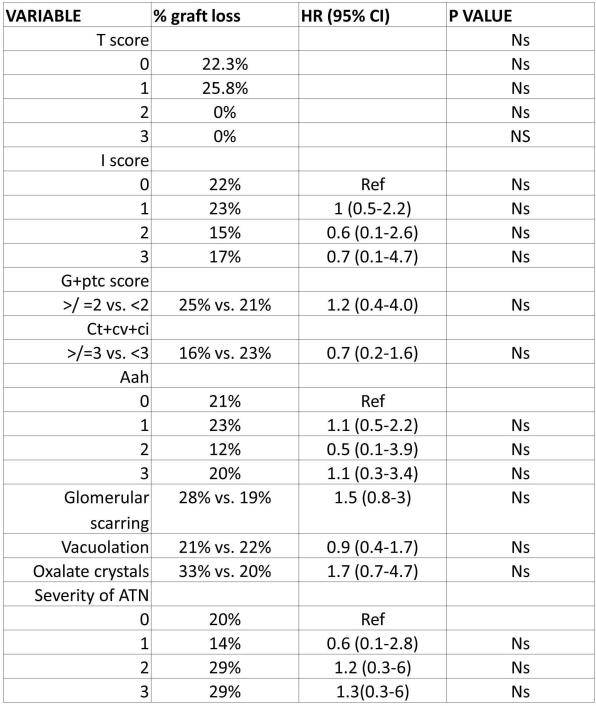Histology of Renal Allografts With DGF Provides Limited Prognostic Information
1Transplantation, Leeds Teaching Hospital, Leeds, United Kingdom
2University of Pittsburgh, Pittsburgh.
Meeting: 2015 American Transplant Congress
Abstract number: B85
Keywords: Graft failure, Inflammation
Session Information
Session Name: Poster Session B: Kidney and Donor Evaluation/Utilization
Session Type: Poster Session
Date: Sunday, May 3, 2015
Session Time: 5:30pm-6:30pm
 Presentation Time: 5:30pm-6:30pm
Presentation Time: 5:30pm-6:30pm
Location: Exhibit Hall E
DGF has been shown to be associated with adverse graft outcomes in renal transplantation. However DGF is heterogeneous histologically and the impact of various histological lesions in patients with DGF has not been previously studied. In this study patients with DGF have been classified histologically based on the 2013 Banff classification and the impact of individual Banff lesions on graft outcomes is analysed.
A total of 164 patients were diagnosed with DGF based on the requirement of dialysis within the first post-transplant week between 2005 and 2013. All these patients were biopsied between day-7 to day-14 post-transplantation. The biopsies were scored by a blinded pathologist and histological scores analysed for their impact on graft outcomes.
The mean tubulitis score for these patients was 0.35 with X% of patients presenting with a tubulitis score≥1. Similarly, 11% of patients had glomerulitis; 12% of patients had interstitial inflammation and 6% of patients had peritubular capillaritis. Whilst 36% of patients had tubular atrophy, only a minority presented with significant tubular scarring (3%). Similar trends were seen with interstitial fibrosis and chronic vascular changes. Significant arteriolar hyalinosis (aah≥2) was noted in 13% of the patients. Most of the patients (94%) presented with acute tubular necrosis (ATN) with a significant proportion presenting with severe ATN (34%). Despite the diverse histological changes noted in this group of patients, none of the histological parameters were associated with long-term (Fig-1) or 1 year graft outcomes. It is noteworthy that neither tubulitis nor microcirculation inflammation was associated with worse graft outcomes in this selective group of patients with DGF.
To conclude, though this study reiterates the diversity of the histological lesions identified in patients with DGF, none of these lesions were significantly associated with adverse graft outcomes.

To cite this abstract in AMA style:
Balasubramanian S, Cherukuri A, Prasad P, Baker R. Histology of Renal Allografts With DGF Provides Limited Prognostic Information [abstract]. Am J Transplant. 2015; 15 (suppl 3). https://atcmeetingabstracts.com/abstract/histology-of-renal-allografts-with-dgf-provides-limited-prognostic-information/. Accessed December 15, 2025.« Back to 2015 American Transplant Congress
